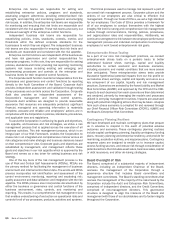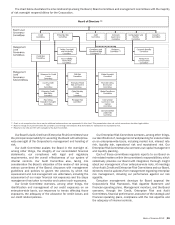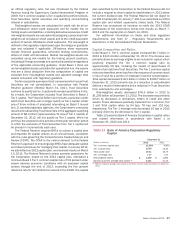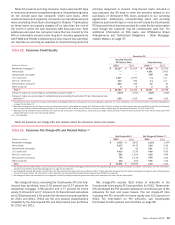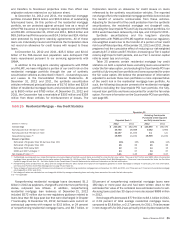Bank of America 2012 Annual Report Download - page 75
Download and view the complete annual report
Please find page 75 of the 2012 Bank of America annual report below. You can navigate through the pages in the report by either clicking on the pages listed below, or by using the keyword search tool below to find specific information within the annual report.
Bank of America 2012 73
Diversified Funding Sources
We fund our assets primarily with a mix of deposits and secured
and unsecured liabilities through a globally coordinated funding
strategy. We diversify our funding globally across products,
programs, markets, currencies and investor groups.
We fund a substantial portion of our lending activities through
our deposits, which were $1.11 trillion and $1.03 trillion at
December 31, 2012 and 2011. Deposits are primarily generated
by our CBB, GWIM and Global Banking segments. These deposits
are diversified by clients, product type and geography, and the
majority of our U.S. deposits are insured by the FDIC. We consider
a substantial portion of our deposits to be a stable, low-cost and
consistent source of funding. We believe this deposit funding is
generally less sensitive to interest rate changes, market volatility
or changes in our credit ratings than wholesale funding sources.
Our lending activities may also be financed through secured
borrowings, including securitizations with GSEs, the FHA and
private-label investors, as well as FHLB loans.
Our trading activities in broker/dealer subsidiaries are primarily
funded on a secured basis through securities lending and
repurchase agreements and these amounts will vary based on
customer activity and market conditions. We believe funding these
activities in the secured financing markets is more cost-efficient
and less sensitive to changes in our credit ratings than unsecured
financing. Repurchase agreements are generally short-term and
often overnight. Disruptions in secured financing markets for
financial institutions have occurred in prior market cycles which
resulted in adverse changes in terms or significant reductions in
the availability of such financing. We manage the liquidity risks
arising from secured funding by sourcing funding globally from a
diverse group of counterparties, providing a range of securities
collateral and pursuing longer durations, when appropriate.
We issue the majority of our long-term unsecured debt at the
parent company. During 2012, the parent company issued $17.6
billion of long-term unsecured debt, including structured liabilities
of $9.2 billion. We may also issue long-term unsecured debt
through BANA in a variety of maturities and currencies to achieve
cost-efficient funding and to maintain an appropriate maturity
profile, although there were no new issuances through BANA during
2012. While the cost and availability of unsecured funding may be
negatively impacted by general market conditions or by matters
specific to the financial services industry or the Corporation, we
seek to mitigate refinancing risk by actively managing the amount
of our borrowings that we anticipate will mature within any month
or quarter.
The primary benefits expected from our centralized funding
strategy include greater control, reduced funding costs, wider name
recognition by investors and greater flexibility to meet the variable
funding requirements of subsidiaries. Where regulations, time
zone differences or other business considerations make parent
company funding impractical, certain other subsidiaries may issue
their own debt.
Table 19 presents our long-term debt by major currency at
December 31, 2012 and 2011.
Table 19 Long-term Debt by Major Currency
December 31
(Dollars in millions) 2012 2011
U.S. Dollar $ 180,329 $ 255,262
Euro 58,985 68,799
Japanese Yen 12,749 19,568
British Pound 11,126 12,554
Canadian Dollar 3,560 4,621
Australian Dollar 2,760 4,900
Swiss Franc 1,917 2,268
Other 4,159 4,293
Total long-term debt $ 275,585 $ 372,265
Total long-term debt decreased $96.7 billion, or 26 percent, in
2012, primarily driven by maturities and liability management
actions. This reflects our ongoing initiative to reduce our debt
balances over time and we anticipate that debt levels will continue
to decline from maturities through 2013. We may, from time to
time, purchase outstanding debt securities in various transactions,
depending on prevailing market conditions, liquidity and other
factors. In addition, our broker/dealer subsidiaries may make
markets in our debt instruments to provide liquidity for investors.
For additional information on long-term debt funding, see Note 12
– Long-term Debt to the Consolidated Financial Statements.
We use derivative transactions to manage the duration, interest
rate and currency risks of our borrowings, considering the
characteristics of the assets they are funding. For further details
on our ALM activities, see Interest Rate Risk Management for
Nontrading Activities on page 113.
We also diversify our unsecured funding sources by issuing
various types of debt instruments including structured liabilities,
which are debt obligations that pay investors returns linked to other
debt or equity securities, indices, currencies or commodities. We
typically hedge the returns we are obligated to pay on these
liabilities with derivative positions and/or investments in the
underlying instruments, so that from a funding perspective, the
cost is similar to our other unsecured long-term debt. We could
be required to settle certain structured liability obligations for cash
or other securities prior to maturity under certain circumstances,
which we consider for liquidity planning purposes. We believe,
however, that a portion of such borrowings will remain outstanding
beyond the earliest put or redemption date. We had outstanding
structured liabilities with a carrying value of $51.7 billion and
$50.9 billion at December 31, 2012 and 2011.
Substantially all of our senior and subordinated debt
obligations contain no provisions that could trigger a requirement
for an early repayment, require additional collateral support, result
in changes to terms, accelerate maturity or create additional
financial obligations upon an adverse change in our credit ratings,
financial ratios, earnings, cash flows or stock price.



